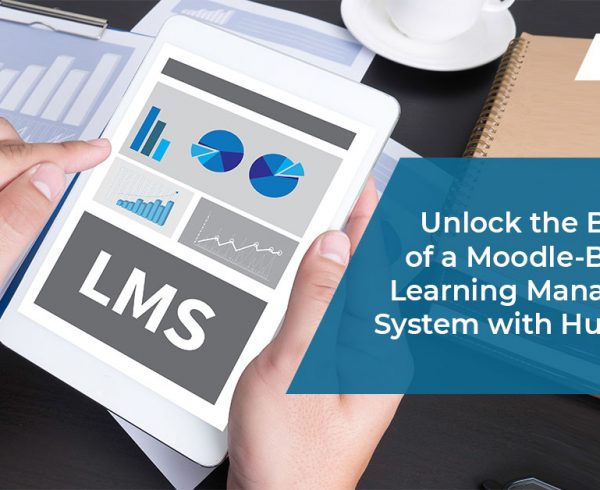Educational institutions use a learning management system to create, deploy, and deliver online or blended courses, with all the elements of traditional classroom learning including instructor-led lessons, assignments, and assessments. The LMS also provides communication and collaboration tools, allowing instructors and learners to collaborate within a cloud-based learning platform. While different types of LMS use different types of technology, Moodle LMS is one of the most widely used LMS, based on open-source technology.
Related Read: 10 Benefits of Moodle-based Learning Management System (LMS)
What is Moodle?
Moodle is an acronym for Modular Object-Oriented Dynamic Learning Environment. This open-source, community-driven platform has to its credit millions of users thanks to its varied feature sets and flexibility. As of date, the Moodle LMS has had over 100,000 implementations worldwide and over 160 million learners to its credit. There is a lot that you can do with a Moodle LMS – from creating classes and making attendance lists to delivering learning modules, giving assessments, sending feedback, and much more. The LMS is very flexible and highly configurable and so professional help may be needed to deploy the platform and set it up to the right functionality. Like other learning management systems, Moodle LMS is a cloud-based system necessitating users to register and authenticate themselves and then access courses and other material from anywhere and anytime using an Internet-enabled device.
How Can Higher Education Institutions Leverage a Moodle LMS
Moodle LMS is also the platform of choice for universities and other higher education institutions. It can easily integrate with the institution’s existing CRM, student information system and tools such as attendance tools and gradebooks. Apart from its immense flexibility, a complete bouquet of features, and future-proof scalability, this LMS is well-supported by a global community of developers, partners and users, all of whom have the ability to improve the original code of the site. Besides, this community constantly examines the best practices of other LMS and incorporates them in Moodle to make it more effective. This implies that higher education institutions using Moodle LMS can stay ahead of the curve with cutting edge technology to meet their evolving educational needs.
The open-source code of Moodle LMS opens up avenues for multiple hosting options, thus enabling higher education institutions to maximize the functionality and efficacy of their online courses. Universities can host their own Moodle site if they have internal expertise and bandwidth, or partner with a Moodle-based LMS service provider. With the latter, they could pass on the responsibility of maintaining the LMS to the third-party service provider and spend their time on engaging with the students than managing the LMS system.
Here are some more benefits of using a Moodle LMS-
Anytime and Anywhere Access to Learning Resources: Moodle is a web-based solution with a robust mobile app. This means that learners don’t have to be restricted to the classroom or have physical resource material at hand. Rather, they can log in to the Moodle LMS on the device of their choice, at anytime and anywhere. This feature makes it a great solution, especially at the time of the current pandemic which has necessitated students to access online classes remotely.
Benefit from Blended Learning: Moodle LMS enables a blended approach to education, which gives students the best of both worlds – offline interaction with the instructor and peers, and access to a wealth of online resources, coupled with discussions on social media, with both internal and external communities.
Real-time Progress Reporting and Feedback: With Moodle LMS, it is possible to ensure that every student has access to all types of resources and content they need, including the plugins required for smooth communication and collaboration. Besides, instructors can track in real-time students’ progress during the course of a lesson, and provide feedback using a comprehensive set of tools. Further, they can also respond to their work, using automated assessment tools, fed on pre-defined criteria.
Timesaving for Teachers: Higher education institutions can integrate Moodle LMS with their existing tools and systems. These tools help to reduce manual labor and so instead of spending time on enrolling and managing their learners, instructors can spend meaningful time interacting with the students. Also, these integrated systems can be effectively managed from a central location, allowing the administrators, students and instructors to track or monitor all information at one place. Besides, the information can be sectioned for authorized access.
User-friendly Interface: Moodle LMS provides a user-friendly interface, a pre-requisite for better user experience, with self-descriptive navigation features. Besides, it is easy to use, which means that you can have it up and running in no time with minimum investment in training.
Create Microlearning Content: Mobile learning and microlearning entail creating very concise content such that large modules have to be broken down into small or micro-bites for learners to consume anytime and anywhere. Microlearning content is usually in the form of an audio or video, or bulleted lists, making it easier to revise the main points of a lesson. With Moodle LMS, you can create microlearning content using the latest cutting-edge technologies and various digital media formats.
Assessment and Testing: Moodle LMS can support both pre-tests and post-tests, both of which are integral to assess learners’ progress. With its flexible testing features, course administrators can automatically mark students’ progress based on pre-set criteria and also store their complete assessment portfolio.
Security: Last but not the least, Moodle LMS offers secure sign-in features to prevent unauthorized access and protect sensitive data. Besides, it also provides controlled access to maintain data integrity at all times.
Related Read: Google Classroom or Moodle – Which is the Better Option for You?
In conclusion
As a higher education institution, if you are looking for an LMS to engage with your learners and at the same time, ease the workload of your instructors, Moodle LMS is a good option. The LMS enables you to tailor your courses to meet the instructors’ teaching styles as also the learning needs of your students. It is a highly advanced system that empowers you to solve the typical challenges you face while creating sustainable learning programs and improving the learning outcomes. Apart from being highly flexible and configurable, this feature-rich LMS has more than 500-plugins developed by a global community of learners, managers and administrators. With these plugins, you can seamlessly perform all administrative functions, collaborate across geographies, deliver remote education and at the same time, make learning collaborative, engaging and fun.
While the Moodle LMS is easy to set up and use, and requires minimum training, it is a good idea to seek support of third-party Moodle LMS service providers to run it with minimum downtime and also customize its features and support services to meet the needs of your educational institution.
At Hurix, we develop fully customizable white-label LMS based on open-source robust Moodle based architecture. Get in touch with us for more information on how we can help you leverage a Moodle LMS for your institution.
Need to know more about our Products & Services ? Drop us a Note.










